Effect of Different Types of Organic Manure on Oil and Fatty Acid Accumulation and Desaturase Gene Expression of Oilseed Flax in the Dry Areas of the Loess Plateau of China
Abstract
:1. Introduction
2. Materials and Methods
2.1. Experimental Site
2.2. Materials
2.3. Experimental Design
2.4. Measurement and Calculation
2.4.1. Grain oil Content
2.4.2. Fatty Acids
2.4.3. Nonstructural Carbohydrates
2.4.4. Gene Expression
- (1)
- Sample collection
- (2)
- Primer design
- (3)
- Total RNA extraction and cDNA reverse transcription
- (4)
- Real-time fluorescence quantitative PCR
2.5. Statistical Analyses
3. Results
3.1. Dynamic Changes in NSC Content
3.1.1. Soluble Sugar Content
3.1.2. Starch Content
3.1.3. Sucrose Content
3.2. Oil and Fatty Acid Accumulation Trend
3.2.1. Grain Oil Content
3.2.2. Grain Oil Yield
3.2.3. Accumulation Rules of Different FA Components
3.3. Desaturase Gene Expression
3.3.1. Analysis of Gene Expression Pattern
3.3.2. fad2a Expression
3.3.3. fad3a Expression
3.3.4. fad3b Expression
4. Discussion
5. Conclusions
Author Contributions
Funding
Data Availability Statement
Conflicts of Interest
References
- Rabetafika, H.; Van Remoortel, V.; Danthine, S.; Paquot, M.; Blecker, C. Flaxseed proteins: Food uses and health benefits. Int. J. Food Sci. Technol. 2011, 46, 221–228. [Google Scholar] [CrossRef]
- Banik, M.; Duguid, S.; Cloutier, S. Transcript profiling and gene characterization of three fatty acid desaturase genes in high, moderate, and low linolenic acid genotypes of flax (Linum usitatissimum L.) and their role in linolenic acid accumulation. Genome 2011, 54, 471–483. [Google Scholar] [CrossRef] [PubMed]
- Kulma, A.; Zuk, M.; Long, S.H.; Qiu, C.S.; Wang, Y.F.; Jankauskiene, S.; Preisner, M.; Kostyn, K.; Szopa, J. Biotechnology of fibrous flax in Europe and China. Ind. Crops Prod. 2015, 68, 50–59. [Google Scholar] [CrossRef]
- Zhang, W. High quality development in direction and countermeasures of specialized oil industry in China. Chin. J. Oil Crop Sci. 2020, 42, 167–174. (In Chinese) [Google Scholar]
- Liu, X.; Li, M.; Guo, P.; Zhang, Z.X. Optimization of water and fertilizer coupling system based on rice grain quality. Agric. Water Manag. 2019, 221, 34–46. [Google Scholar] [CrossRef]
- Scheiner, J.D.; Gutiérrez-Boem, F.H.; Lavado, R.S. Sunflower nitrogen requirement and 15N fertilizer recovery in Western Pampas, Argentina. Eur. J. Agron. 2002, 17, 73–79. [Google Scholar] [CrossRef]
- Płaza, A.; Gąsiorowska, B.; Rzązewska, E.; Cybulska, A.; Gorski, R. The effect of manuring with undersown catch crop, and production system on the potato tuber content of microelements. Ital. J. Agron. 2019, 14, 176–182. [Google Scholar] [CrossRef]
- Kumar, S.; Sharma, A.; Rosin, K.G.; Sharma, V.K.; Sinha, S.K.; Kumar, D.; Dwivedi, N.; Vishwanath. Medium-term Impact of Organic and Microbial Fertilization on Production Efficiency and Fertility of Soil in an Apple Production System under North West Himalayan Region. Commun. Soil Sci. Plant Anal. 2022, 53, 346–363. [Google Scholar] [CrossRef]
- Li, T.T.; Xue, J.Q.; Wang, S.L.; Xue, Y.Q.; Hu, F.R.; Zhang, X.X. Research advances in the metabolism and transport of non-structural carbohydrates in plants. Plant Physiol. J. 2018, 54, 25–35. (In Chinese) [Google Scholar]
- Walker, R.P.; Battistelli, A.; Bonghi, C.; Drincovich, M.F.; Falchi, R.; Lara, M.V.; Moscatello, S.; Vizzotto, G.; Famiani, F. Non-structural carbohydrate metabolism in the flesh of stone fruits of the genus Prunus (Rosaceae)–A review. Front. Plant Sci. 2020, 11, 549921. [Google Scholar] [CrossRef]
- Huan, C.; Du, X.; Wang, L.; Kebbeh, M.; Li, H.H.; Yang, X.H.; Shen, S.L.; Zheng, X.L. Transcriptome analysis reveals the metabolisms of starch degradation and ethanol fermentation involved in alcoholic off-flavour development in kiwifruit during ambient storage. Postharvest Biol. Technol. 2021, 180, 111621. [Google Scholar] [CrossRef]
- Wang, Y.Y.; Shi, D.S.; Zhu, H.; Yin, H.X.; Wang, G.Y.; Yang, A.Q.; Song, Z.X.; Jing, Q.Q.; Shuai, B.L.; Xu, N.K. Revisiting maize Brittle endosperm-2 reveals new insights in BETL development and starchy endosperm filling. Plant Sci. 2023, 332, 111727. [Google Scholar] [CrossRef] [PubMed]
- Wei, H.X.; Guo, P. Carbohydrate metabolism during new root growth in transplanted Larix olgensis seedlings: Post-transplant response to nursery-applied inorganic fertilizer and organic amendment. Iforest-Biogeosciences For. 2016, 10, 15–22. [Google Scholar] [CrossRef]
- Mohammadi, K.; Rokhzadi, A. An integrated fertilization system of canola (Brassica napus L.) production under different crop rotations. Ind. Crops Prod. 2012, 37, 264–269. [Google Scholar] [CrossRef]
- Mohammadi, K.; Ghalavand, A.; Aghaalikhani, M.; Heidari, G.; Shahmoradi, B.; Sohrabi, Y. Effect of different methods of crop rotation and fertilization on canola traits and soil microbial activity. Aust. J. Crop Sci. 2011, 5, 1261–1268. [Google Scholar]
- Mohammadi, K. Grain oil and fatty acids composition of soybean affected by nano-iron chelate, chemical fertilizers and farmyard manure. Arch. Agron. Soil Sci. 2015, 61, 1593–1600. [Google Scholar] [CrossRef]
- Makkar, C.; Singh, J.; Parkash, C. Modulatory role of vermicompost and vermiwash on growth, yield and nutritional profiling of Linum usitatissimum L. (Linseed): A field study. Environ. Sci. Pollut. Res. 2019, 26, 3006–3018. [Google Scholar] [CrossRef]
- Wei, T.; Dong, L.; Zhong, S.Y.; Jing, H.S.; Deng, Z.Y.; Wen, Q.; Li, J. Chemical composition of Camellia chekiangoleosa Hu. seeds during ripening and evaluations of seed oils quality. Ind. Crops Prod. 2022, 177, 114499. [Google Scholar] [CrossRef]
- Lin, W.Z.; Ma, S.; Li, Y.J.; Zhang, J.M.; Tan, D.G.; Deng, R.R.; Liu, P.H. Comparative transcriptome analysis of molecular regulation mechanism of lipid and starch accumulation in microalgae Ankistrodesmus sp. HJ12 under nitrogen limitation. China Oils Fats 2023, 48, 137–145. (In Chinese) [Google Scholar]
- Shanklin, J.; Cahoon, E. Desaturation and related modifications of fatty acids. Annu. Rev. Plant Biol. 1998, 49, 611–641. [Google Scholar] [CrossRef]
- Koushirou, S.; Ken-ichi, H.; Naoki, F.; Hideyuki, S.; Koutarou, N.; Fuminori, S.; Yoshie, H.; Isao, M.; Takahisa, M.; Shoji, H.; et al. Two Low–temperature-inducible Chlorella Genes for delta12 and ω-3 Fatty Acid Desaturase (fad): Isolation of delta12 and ω-3 fad cDNA Clones, Expression of delta12 fad in Saccharomyces cerevisiae, and Expression of ω-3 fad in Nicotiana tabacum. Biosci. Biotechnol. Biochem. 2002, 66, 1314–1327. [Google Scholar]
- Oliveira, R.; Robl, D.; Ienczak, J.L. Potential of Mortierellaceae for polyunsaturated fatty acids production: Mini review. Biotechnol. Lett. 2023, 45, 741–759. [Google Scholar] [CrossRef] [PubMed]
- Chen, G.; Li, S. Plant Physiology Experiment; Higher Education Press: Beijing, China, 2016. [Google Scholar]
- Zhang, T. Identification and Functional Analysis of microRNAs Involving in Seed Development and Fatty Acid Metabolism in Linum usitatissimum L. Ph.D. Thesis, Chinese Academy of Agricultural Science, Beijing, China, 2021. (In Chinese). [Google Scholar]
- Davidson, A.M.; Le, S.T.; Cooper, K.B.; Lange, E.; Zweeniecki, M.A. No time to rest: Seasonal dynamics of non-structural carbohydrates in twigs of three Mediterranean tree species suggest year-round activity. Sci. Rep. 2021, 11, 5181. [Google Scholar] [CrossRef] [PubMed]
- Gao, F.C.; Li, H.J.; Mu, X.G.; Gao, H.; Zhang, Y.; Li, R.M.; Cao, K.; Ye, L. Effects of Organic Fertilizer Application on Tomato Yield and Quality: A Meta-Analysis. Appl. Sci. 2023, 13, 2184. [Google Scholar] [CrossRef]
- Yu, H.Y.; Ding, W.X.; Luo, J.F.; Donnison, A.; Zhang, J.B. Long-term effect of compost and inorganic fertilizer on activities of carbon-cycle enzymes in aggregates of an intensively cultivated sandy loam. Soil Use Manag. 2012, 28, 347–360. [Google Scholar] [CrossRef]
- Wu, X.M.; Xu, H.Y.; Gao, J.X. Effects of combined application of organic fertilizer and corn straw on growth, yield and quality of continuous cropping pepper in tunnel. J. North. Agric. 2021, 49, 114–120. (In Chinese) [Google Scholar]
- Gebbing, T.; Schnyder, H. Pre-anthesis reserve utilization for protein and carbohydrate synthesis in grains of wheat. Plant Physiol. 1999, 121, 871–878. [Google Scholar] [CrossRef] [PubMed]
- Rong, N.; Han, Y.L.; Rong, X.M.; Song, H.X.; Peng, J.W.; Xie, G.X.; Zhang, Y.P.; Zhang, Z.H. Response of NO3− uptake and distribution and nitrogen use efficiency in oilseed rape to limited nitrogen stress. J. Plant Nutr. Fertil. 2017, 23, 1104–1111. (In Chinese) [Google Scholar]
- Yan, B.; Wu, B.; Gao, Y.H.; Wu, J.M.; Niu, J.Y.; Xie, Y.P.; Cui, Z.J.; Zhang, Z.K. Effects of nitrogen and phosphorus on the regulation of nonstructural carbohydrate accumulation, translocation and the yield formation of oilseed flax. Field Crops Res. 2018, 219, 229–241. [Google Scholar] [CrossRef]
- Zhao, H.Y.; Sun, S.M.; Zhang, L.H.; Yang, J.J.; Wang, Z.Y.; Ma, F.W.; Li, M.J. Carbohydrate metabolism and transport in apple roots under nitrogen deficiency. Plant Physiol. Biochem. 2020, 155, 455–463. [Google Scholar] [CrossRef]
- Yin, Z.X.; Fan, S.H.; Xia, W.; Zhou, Y.; Zhou, X.; Zhang, X.; Li, C.J.; Guan, F.Y. Response of growth, metabolism and yield of Dendrocalamopsis oldhami to long-day photoperiod and fertilizer compensation. J. For. Res. 2023, 34, 151–166. [Google Scholar] [CrossRef]
- Wang, X.D.; Wang, H.B.; Qin, D.; Zhai, H. Biological Effects of 4 Organic Manures on Potted Grapevines. Chin. Agric. Sci. Bull. 2007, 153, 260–264. (In Chinese) [Google Scholar]
- Scofield, G.N.; Ruuska, S.A.; Aoki, N.; Lewis, D.C.; Tabe, L.M.; Jenkins, C.L.D. Starch storage in the stems of wheat plants: Localization and temporal changes. Ann. Bot. 2009, 103, 859–868. [Google Scholar] [CrossRef] [PubMed]
- Shahid, M.; Cai, G.Q.; Zu, F.; Zhao, Q.; Qasim, M.U.; Hong, Y.Y.; Fan, C.C.; Zhou, Y.M. Comparative transcriptome analysis of developing seeds and silique wall reveals dynamic transcription networks for effective oil production in Brassica napus L. Int. J. Mol. Sci. 2019, 20, 1982. [Google Scholar] [CrossRef]
- Vigeolas, H.; Mohlmann, T.; Martini, N.; Neuhaus, H.E.; Geigenberger, P. Embryo-specific reduction of ADP-Glc pyrophosphorylase leads to an inhibition of starch synthesis and a delay in oil accumulation in developing seeds of oilseed rape. Plant Physiol. 2004, 136, 2676–2686. [Google Scholar] [CrossRef] [PubMed]
- Andriotis, V.M.E.; Pike, M.J.; Kular, B.; Rawsthorne, S.; Smith, A.M. Starch turnover in developing oilseed embryos. New Phytologist 2010, 187, 791–804. [Google Scholar] [CrossRef] [PubMed]
- Zhao, N.; Zhang, Y.; Wang, J.; Liu, X.; Zhao, C.G.; Guo, H.H. Seed Development, Lipid Accumulation and Its Relationship with Carbohydrates and Protein in Xanthoceras sorbifolia Bunge. Bull. Bot. Res. 2015, 35, 133–140+145. (In Chinese) [Google Scholar]
- Borisjuk, L.; Rolletschek, H.; Radchuk, R.; Weschke, W.; Wobus, U.; Weber, H. Seed development and differentiation: A role for metabolic regulation. Plant Biol. 2004, 6, 375–386. [Google Scholar] [CrossRef]
- Larkin, P.J.; Zhou, X.R.; Liu, Q.; Reynolds, K.; Vanhercke, T.; Ral, J.P.; Li, Z.; Wu, X.B.; Yu, R.; Luo, J.X.; et al. A transcriptional journey from sucrose to endosperm oil bodies in triple transgene oily wheat grain. J. Cereal Sci. 2021, 100, 103268. [Google Scholar] [CrossRef]
- Alzamel, N.M.; Taha, E.M.M.; Bakr, A.A.A.; Loutfy, N. Effect of organic and inorganic fertilizers on soil properties, growth yield, and physiochemical properties of sunflower seeds and oils. Sustainability 2022, 14, 12928. [Google Scholar] [CrossRef]
- Grant, C.A.; Derksen, D.A.; McLaren, D.; Irvine, R.B. Nitrogen fertilizer and urease inhibitor effects on canola seed quality in a one-pass seeding and fertilizing system. Field Crops Res. 2011, 121, 201–208. [Google Scholar] [CrossRef]
- Rathke, G.W.; Christen, O.; Diepenbrock, W. Effects of nitrogen source and rate on productivity and quality of winter oilseed rape (Brassica napus L.) grown in different crop rotations. Field Crops Res. 2005, 94, 103–113. [Google Scholar] [CrossRef]
- Bhatia, C.R.; Rabson, R. Bioenergetic considerations in cereal breeding for protein improvement. Science 1976, 194, 1418–1421. [Google Scholar] [CrossRef] [PubMed]
- Lambers, H.; Poorter, H. Inherent variation in growth rate between higher plants: A search for physiological causes and ecological consequences. Adv. Ecol. Res. 1992, 23, 187–261. [Google Scholar]
- Saraiva, F.M.; Dubeux, J.C.B.; da Cunha, M.V.; Menezes, R.S.C.; dos Santos, M.V.F.; Camelo, D.; Ferraz, I. Manure source and cropping system affect nutrient uptake by cactus (Nopalea cochenillifera Salm Dyck). Agronomy 2021, 11, 1512. [Google Scholar] [CrossRef]
- Wondolowska-Grabowska, A. Effect of diversified fertilization with nitrogen, sulphur and boron on fatty acids profile in oil flax seeds. J. Elem. 2014, 19, 1131–1142. [Google Scholar] [CrossRef]
- Zhang, A.X.; Liu, X.D.; Wang, G.R.; Wang, H.J.; Liu, J.K.; Zhao, W.; Zhang, Y.Z. Crude fat content and fatty acid profile and their correlations in foxtail millet. Cereal Chem. 2015, 92, 455–459. [Google Scholar] [CrossRef]
- Helmy, A.M.; Ramadan, M.F. Agronomic performance and chemical response of sunflower (Helianthus annuus L.) to some organic nitrogen sources and conventional nitrogen fertilizers under sandy soil conditions. Grasas Aceites 2009, 60, 55–67. [Google Scholar]
- Petropoulos, S.A.; Fernandes, A.; Xyrafis, E.; Polyzos, N.; Antoniadis, V.; Barros, L.; Ferreira, I.C.F.R. The optimization of nitrogen fertilization regulates crop performance and quality of processing tomato (Solanum lycopersicum L. cv. Heinz 3402). Agronomy 2020, 10, 715. [Google Scholar] [CrossRef]
- Hassan, M.O.; Saleh, A.M.; AbdElgawad, H. Sonchus oleraceus residue improves nutritive and health-promoting value of common bean (Phaseolus vulgaris L.): A metabolic study. J. Agric. Food Chem. 2018, 66, 2092–2100. [Google Scholar] [CrossRef]
- Zheljazkov, V.D.; Vick, B.; Ebelhar, M.W.; Buehring, N.; Astatkie, T. Nitrogen applications modify seed and oil yields and fatty acid composition of winter mustard. Ind. Crops Prod. 2012, 36, 28–32. [Google Scholar] [CrossRef]
- Xie, Y.p.; Lv, Z.C.; Wang, L.M.; Zhang, J.P.; Song, M.G.; Shi, X.F.; Zhao, W.; Zhao, L.; Li, W.J.; Qi, Y.N.; et al. Effect of seeding density and nitrogen rates on yield and quality of oilseed flax under irrigation. Chin. J. Oil Crop Sci. 2021, 43, 277–285. (In Chinese) [Google Scholar]
- Gutierrez, L.; Mauriat, M.; Gunin, S.; Pelloux, J.; Lefebvre, J.-F.; Louvet, R.; Rusterucci, C.; Moritz, T.; Guerineau, F.; Bellini, C.; et al. The lack of a systematic validation of reference genes: A serious pitfall undervalued in reverse transcription-polymerase chain reaction (RT-PCR) analysis in plants. Plant Biotechnol. J. 2018, 6, 609–618. [Google Scholar] [CrossRef] [PubMed]
- You, F.M.; Li, P.; Kumar, S.; Ragupathy, R.; Li, Z.; Fu, Y.B.; Cloutier, S. Genome-wide identification and characterization of the gene families controlling fatty acid biosynthesis in flax (Linum usitatissimum L). J. Proteom. Bioinform. 2014, 7, 310–326. [Google Scholar]
- Berestovoy, M.A.; Pavlenko, O.S.; Goldenkova-Pavlova, I.V. Plant fatty acid desaturases: Role in the life of plants and biotechnological potential. Biol. Bull. Rev. 2020, 10, 127–139. [Google Scholar] [CrossRef]
- Dvorianinova, E.M.; Zinovieva, O.L.; Pushkova, E.N.; Zhernova, D.A.; Rozhmina, T.A.; Povkhova, L.V.; Novakovskiy, R.O.; Sigova, E.A.; Turba, A.A.; Borkhert, E.V.; et al. Key FAD2, FAD3, and SAD Genes Involved in the Fatty Acid Synthesis in Flax Identified Based on Genomic and Transcriptomic Data. Int. J. Mol. Sci. 2023, 24, 14885. [Google Scholar] [CrossRef] [PubMed]
- Rajwade, A.V.; Kadoo, N.Y.; Borikar, S.P.; Harsulkar, A.M.; Ghorpade, P.B.; Gupta, V.S. Differential transcriptional activity of SAD, fad2 and fad3 desaturase genes in developing seeds of linseed contributes to varietal variation in α-linolenic acid content. Phytochemistry 2014, 98, 41–53. [Google Scholar] [CrossRef] [PubMed]
- Rajwade, A.V.; Joshi, R.S.; Kadoo, N.Y.; Gupta, V.S. Sequence characterization and in silico structure prediction of fatty acid desaturases in linseed varieties with differential fatty acid composition. J. Sci. Food Agric. 2016, 96, 4896–4906. [Google Scholar] [CrossRef]
- Thambugala, D.; Duguid, S.; Loewen, E.; Rowland, G.; Booker, H.; You, F.M.; Cloutier, S. Genetic variation of six desaturase genes in flax and their impact on fatty acid composition. Theor. Appl. Genet. 2013, 126, 2627–2641. [Google Scholar] [CrossRef]
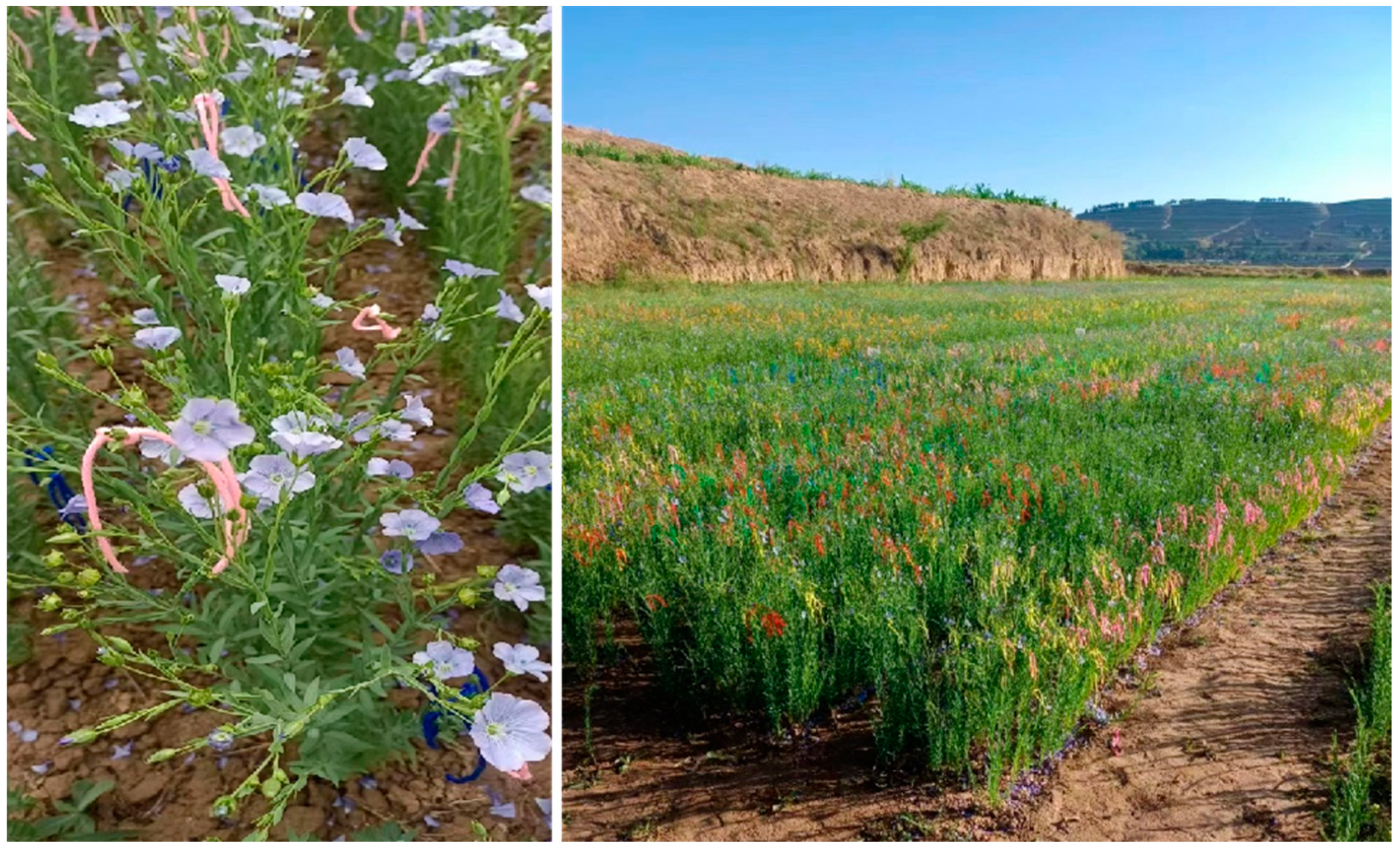
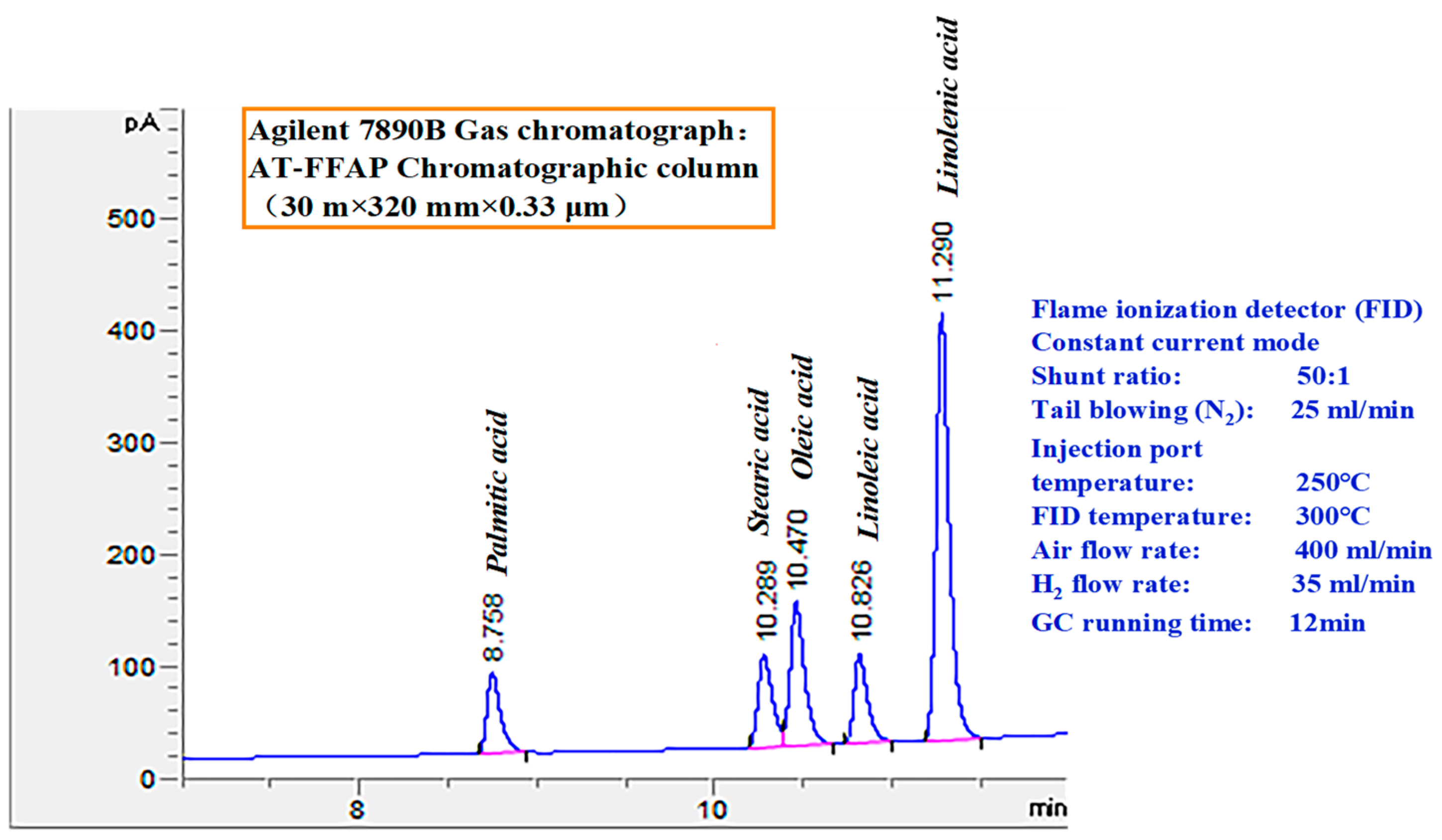
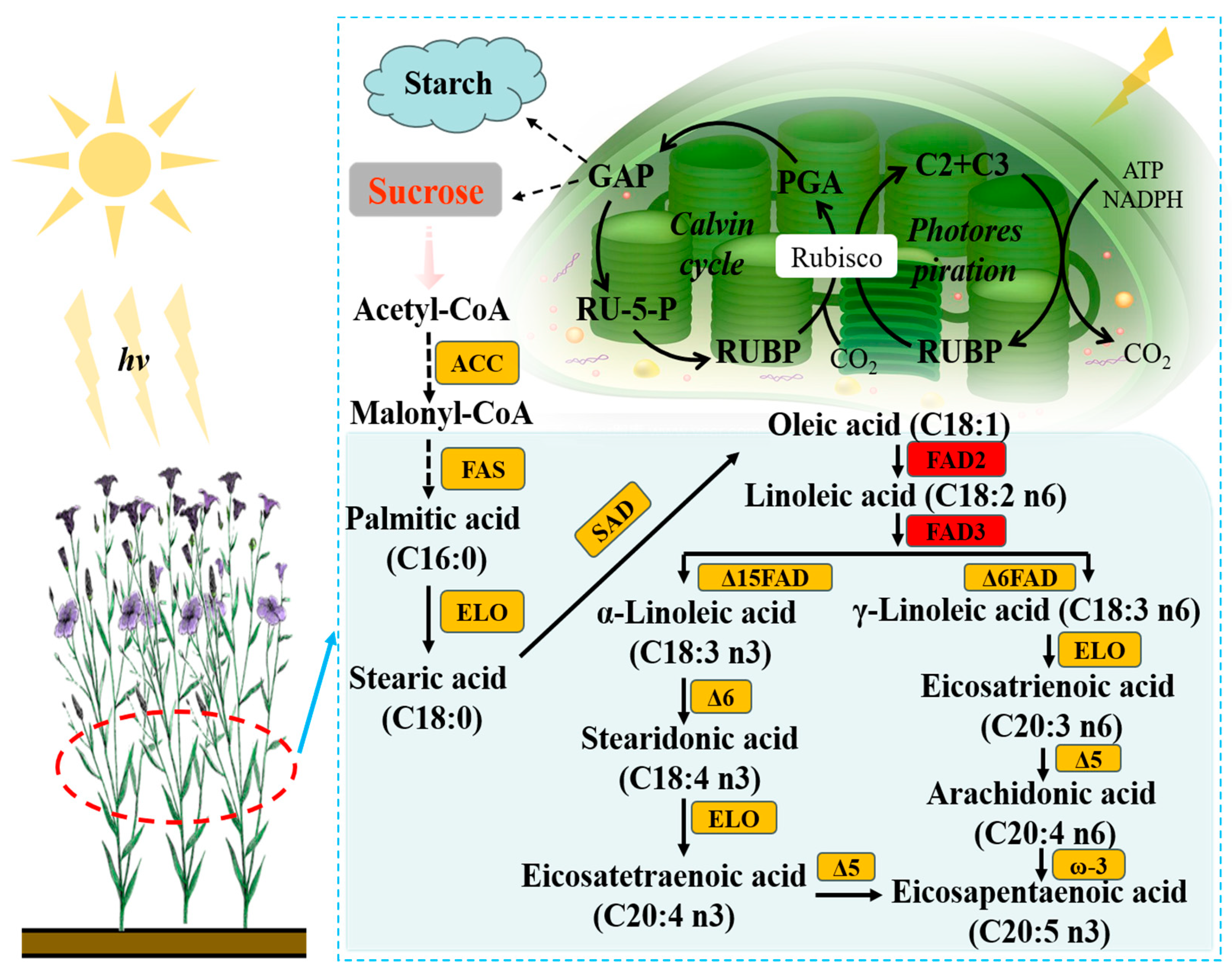
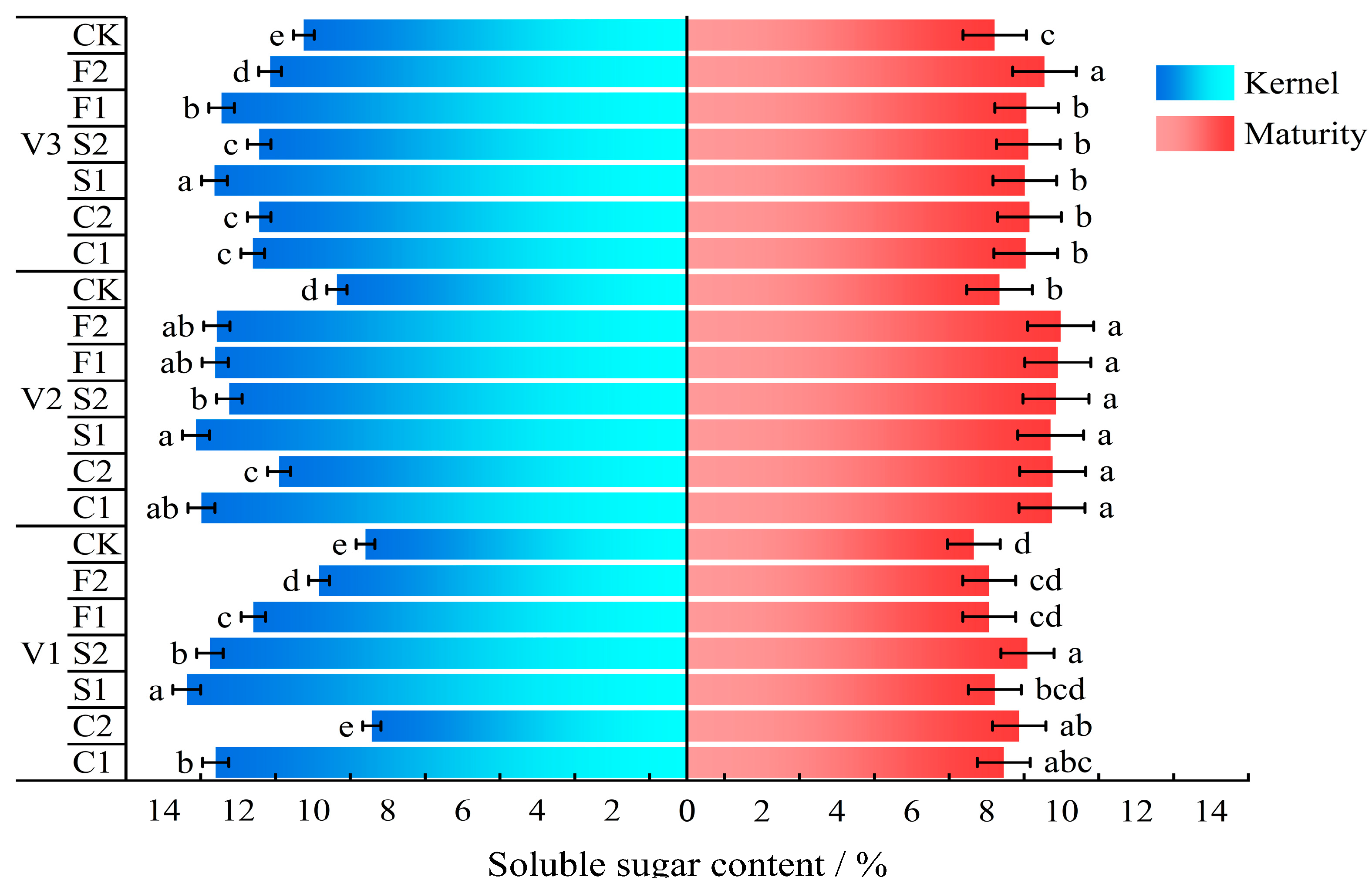
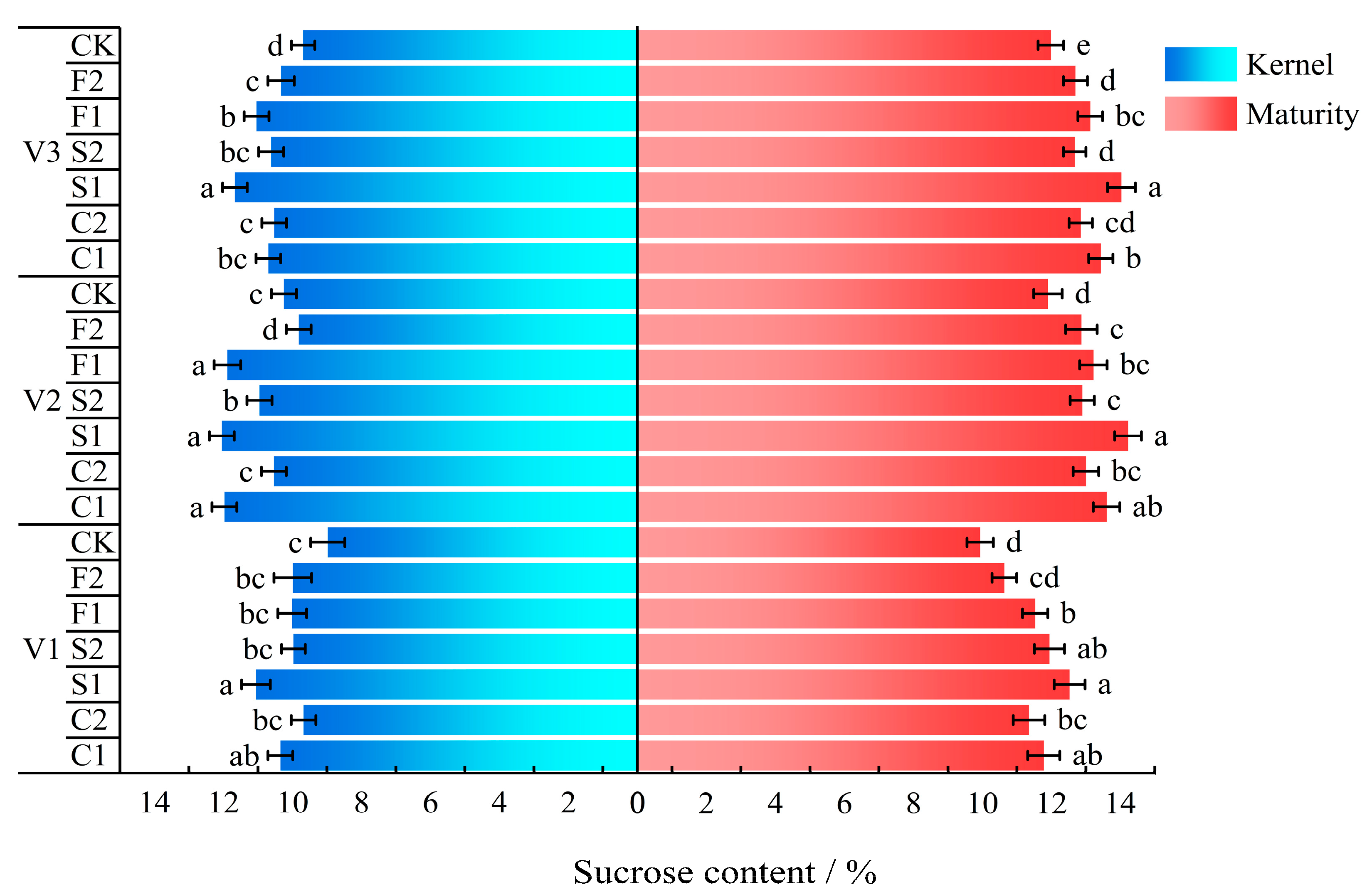
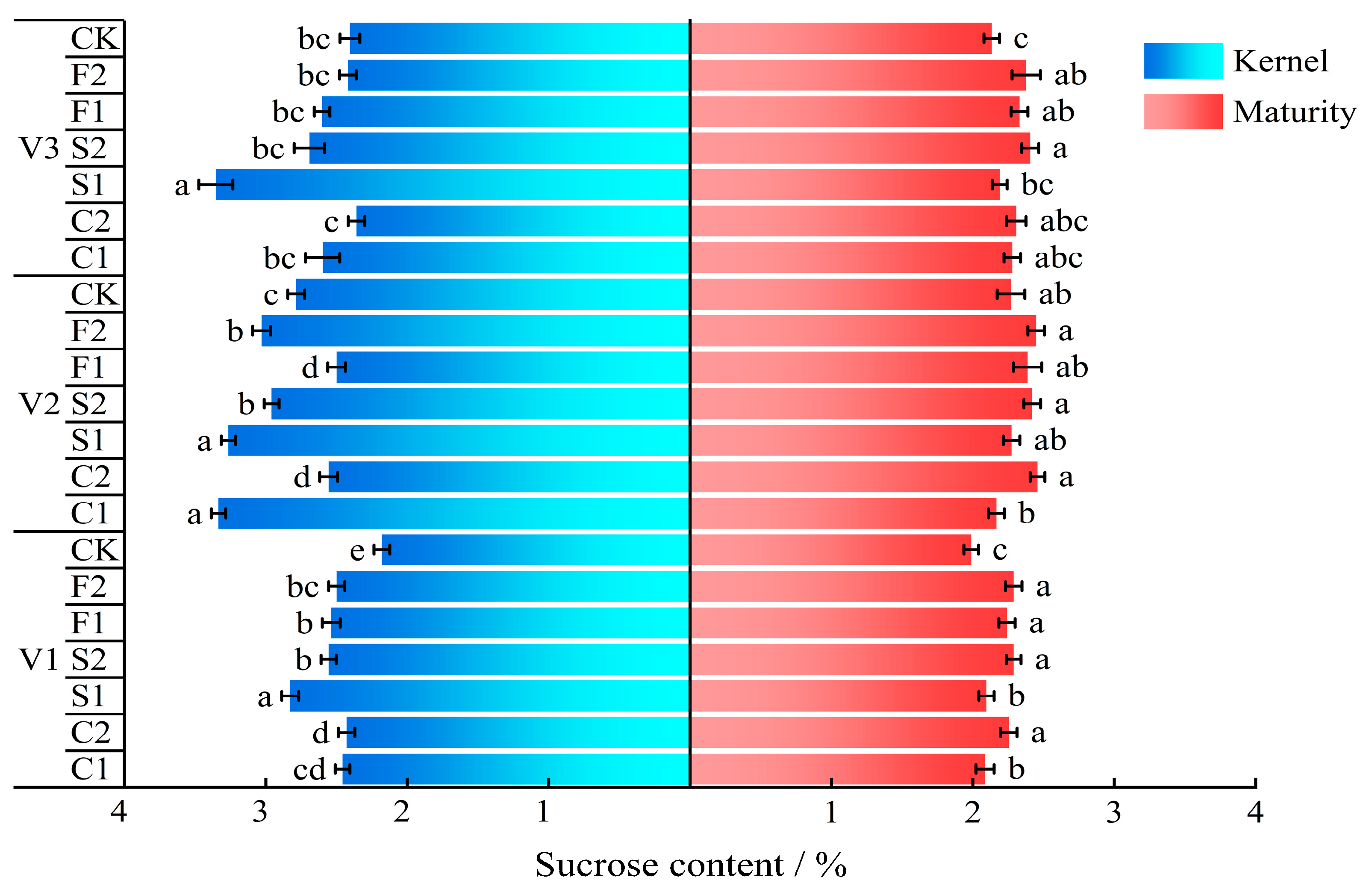

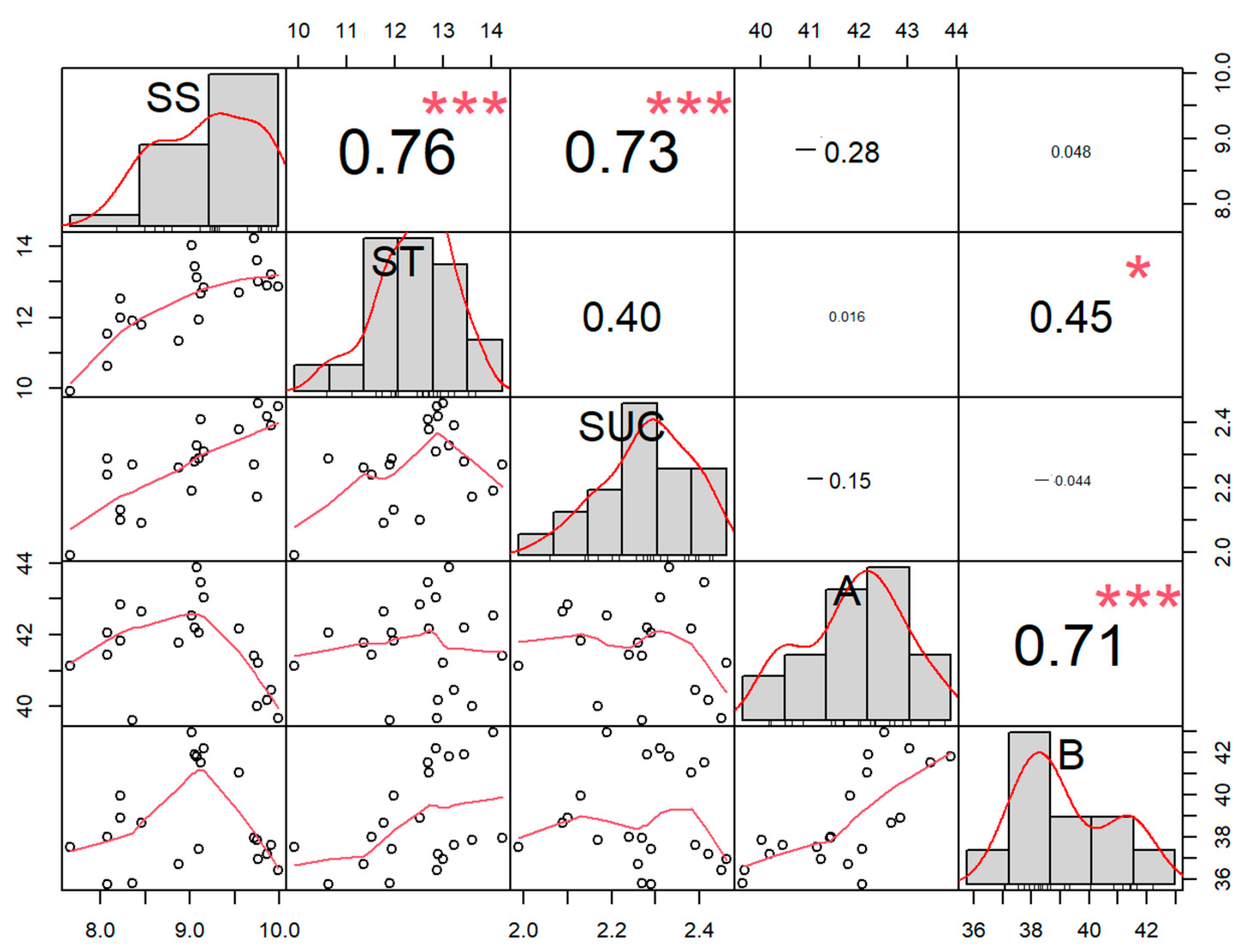
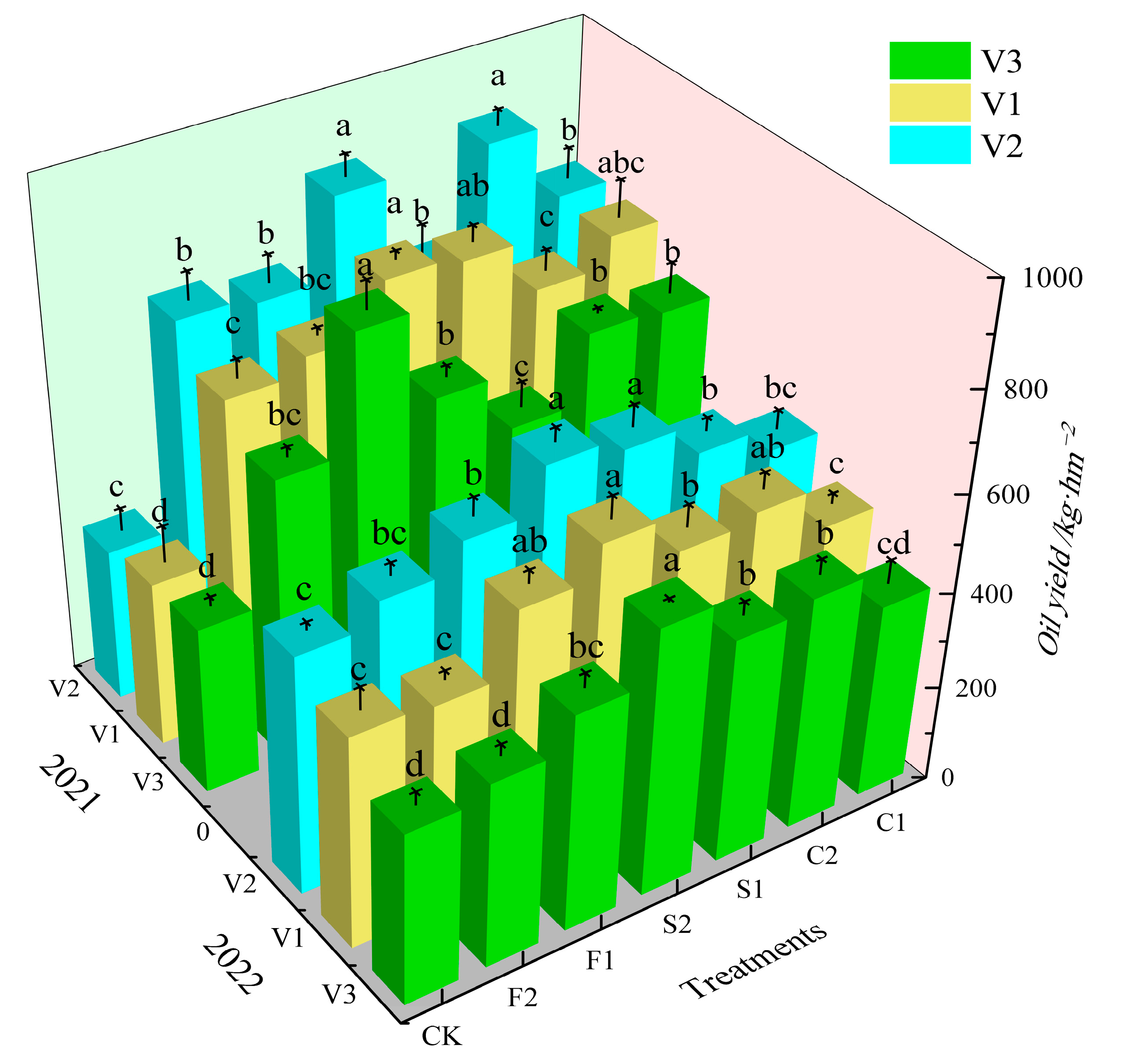
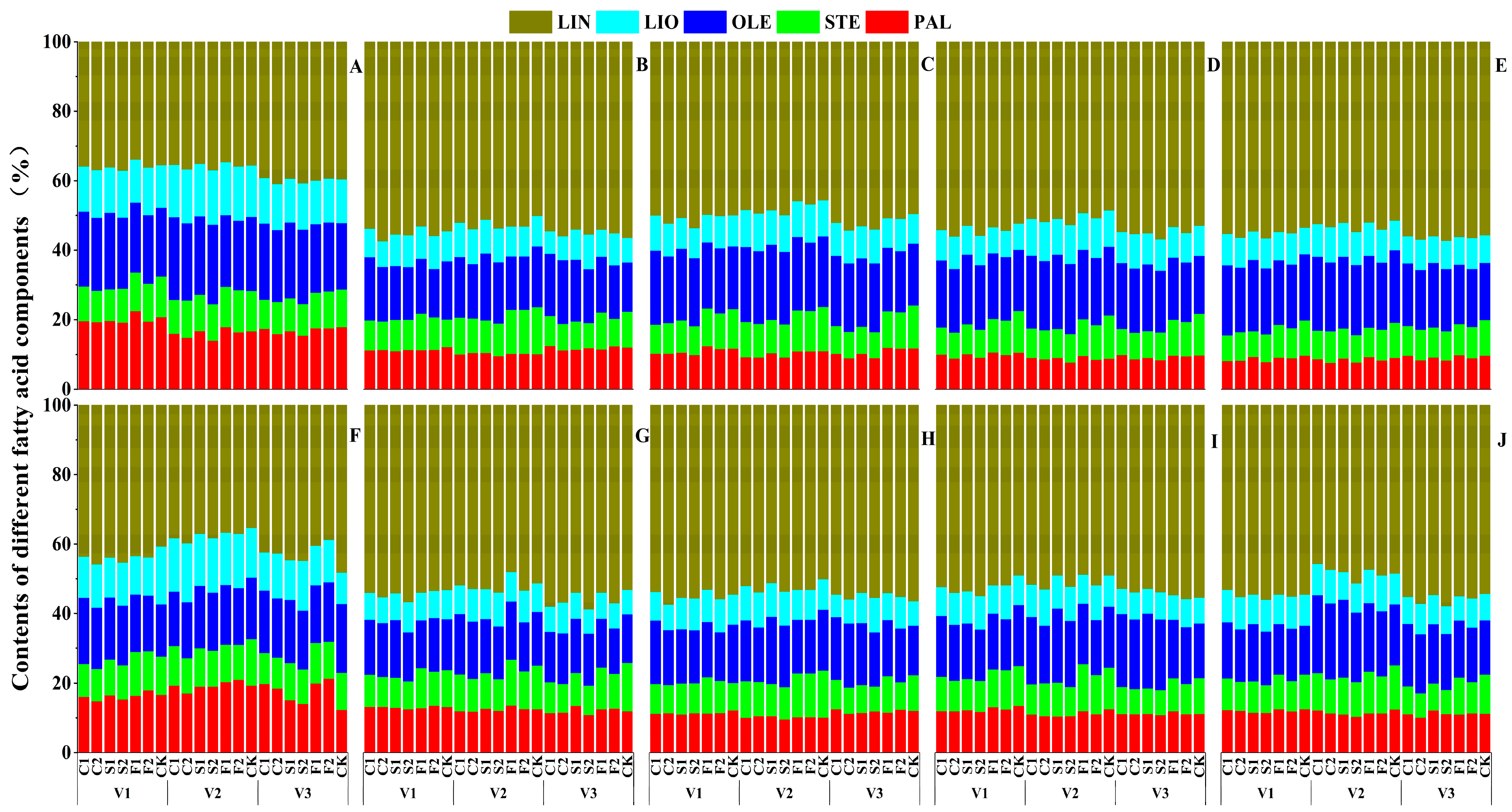
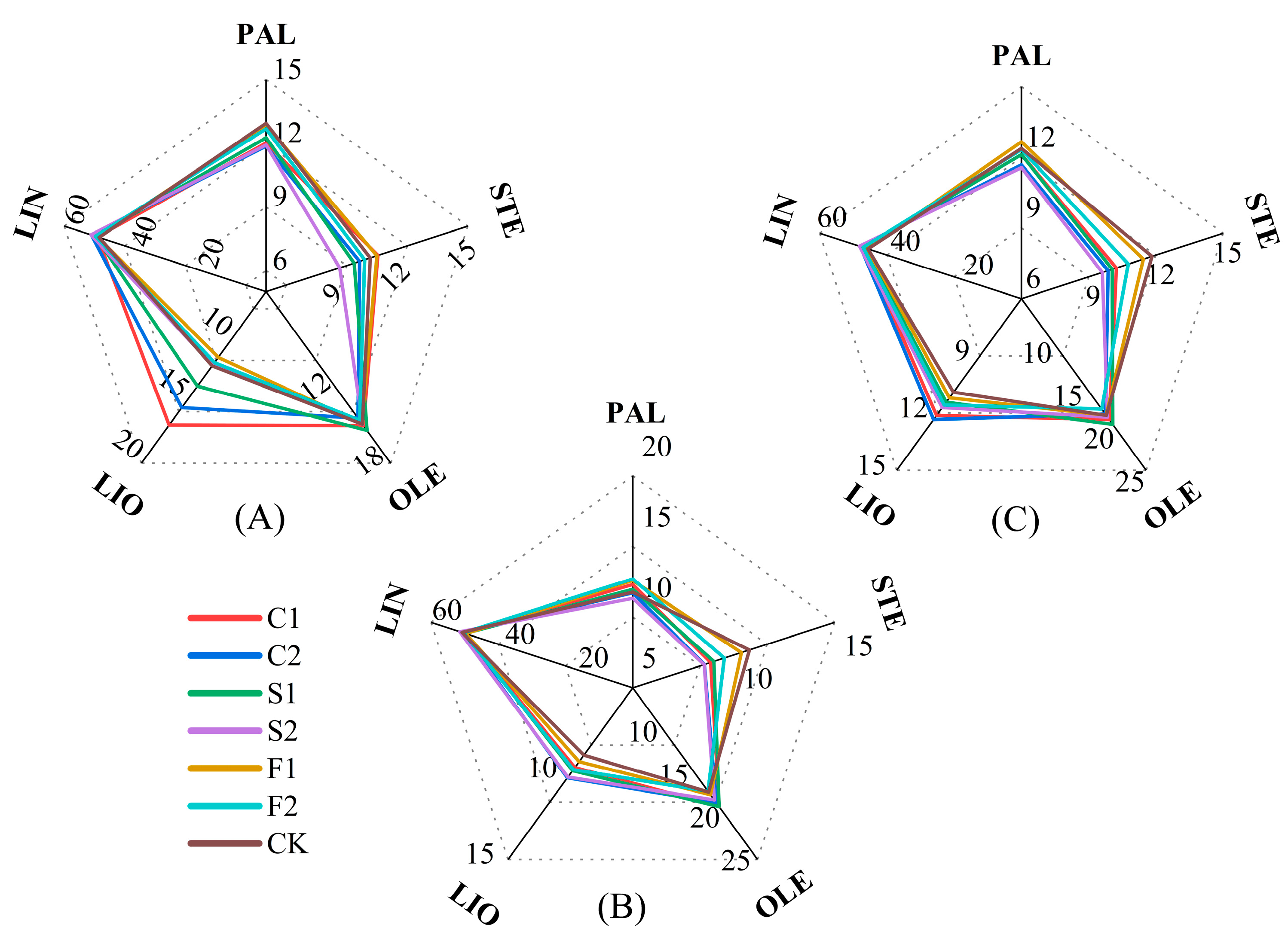
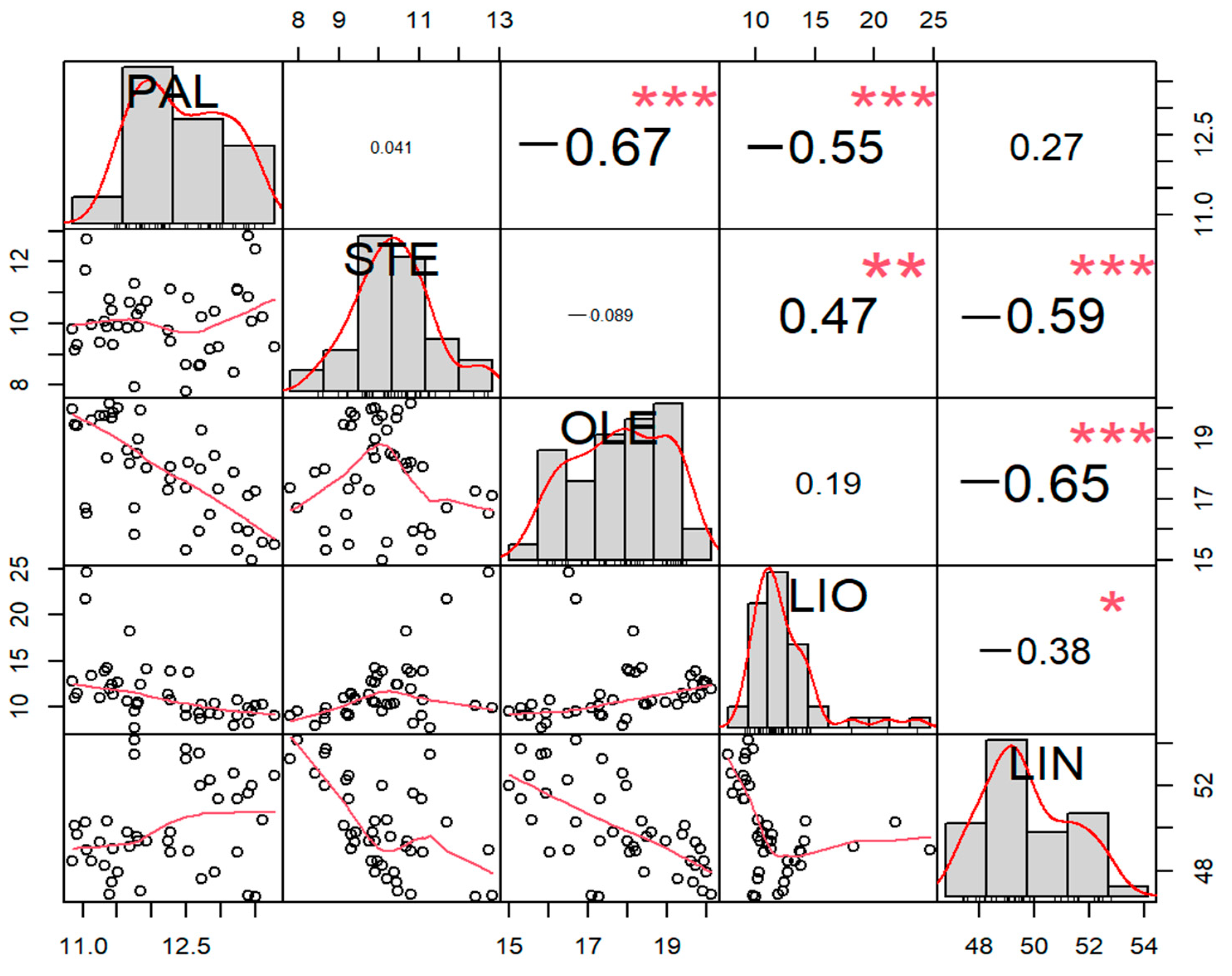
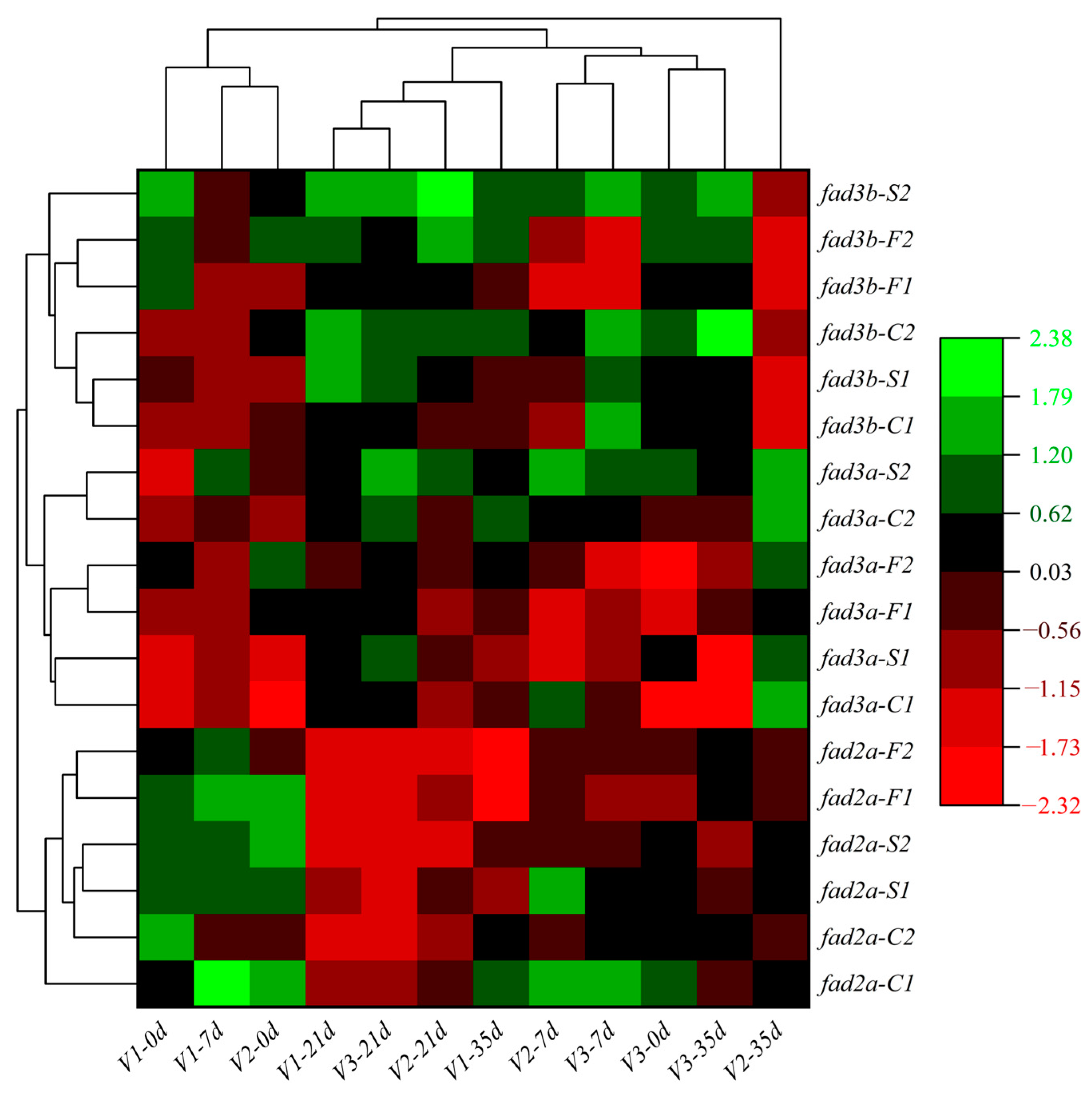
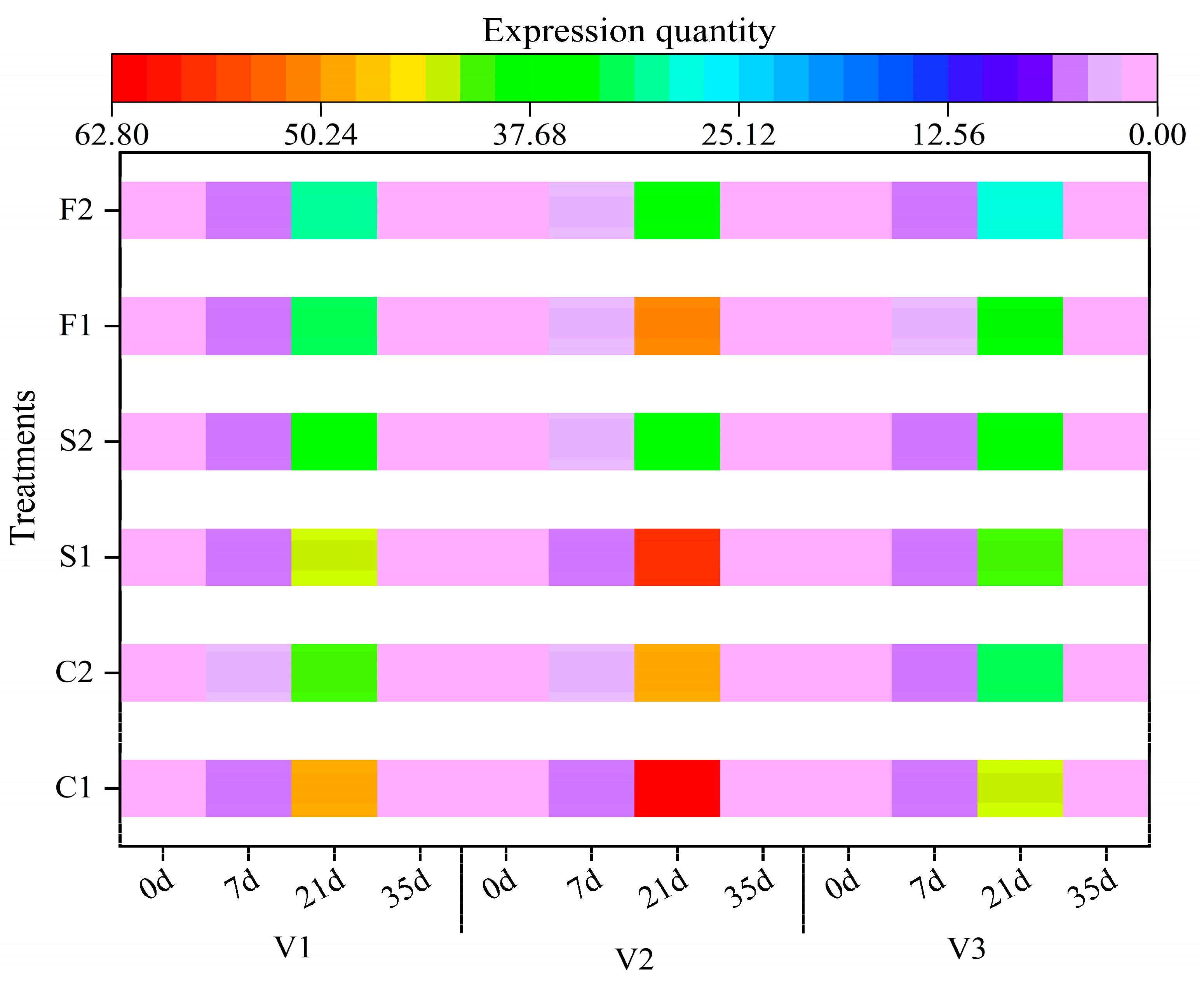
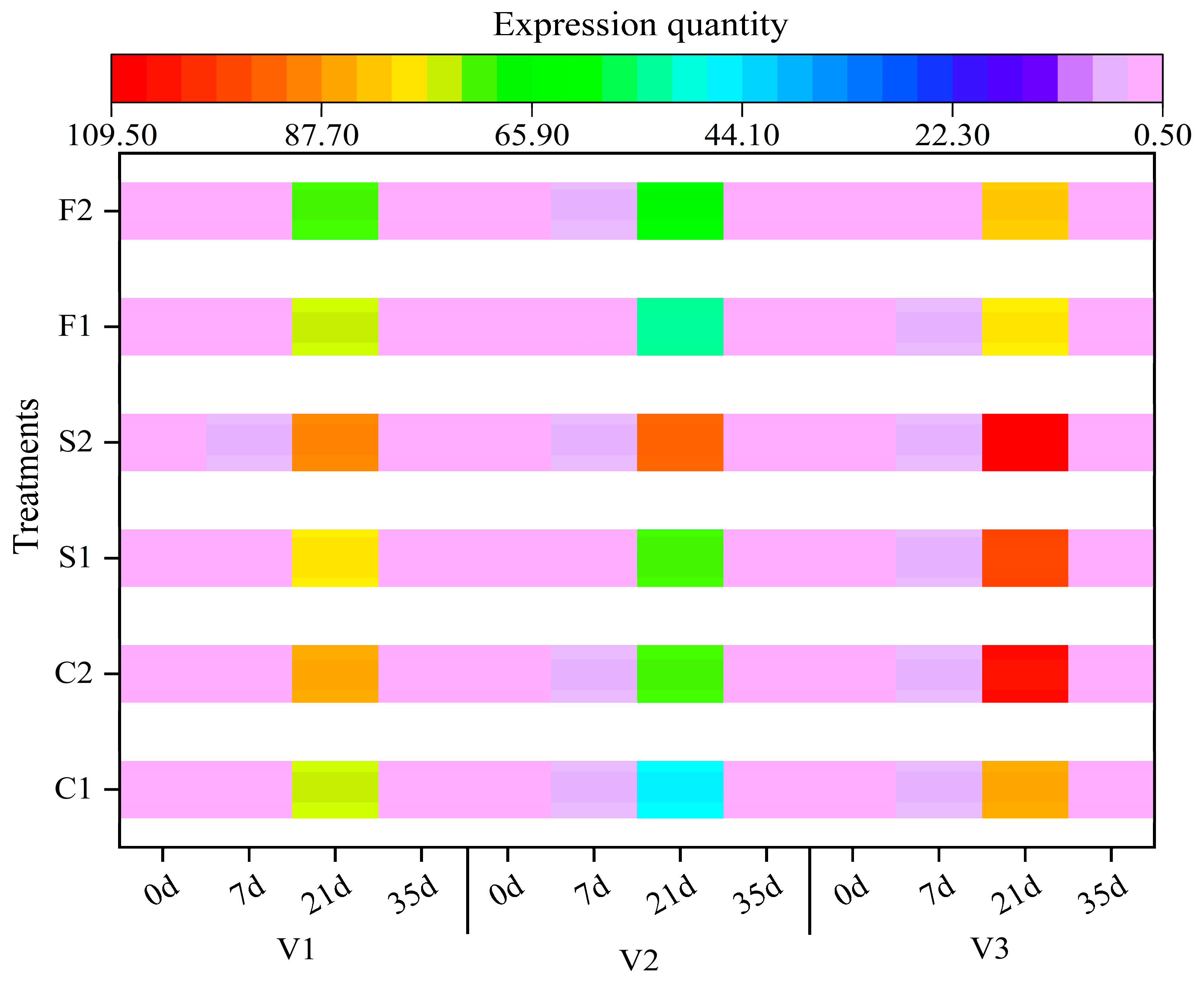
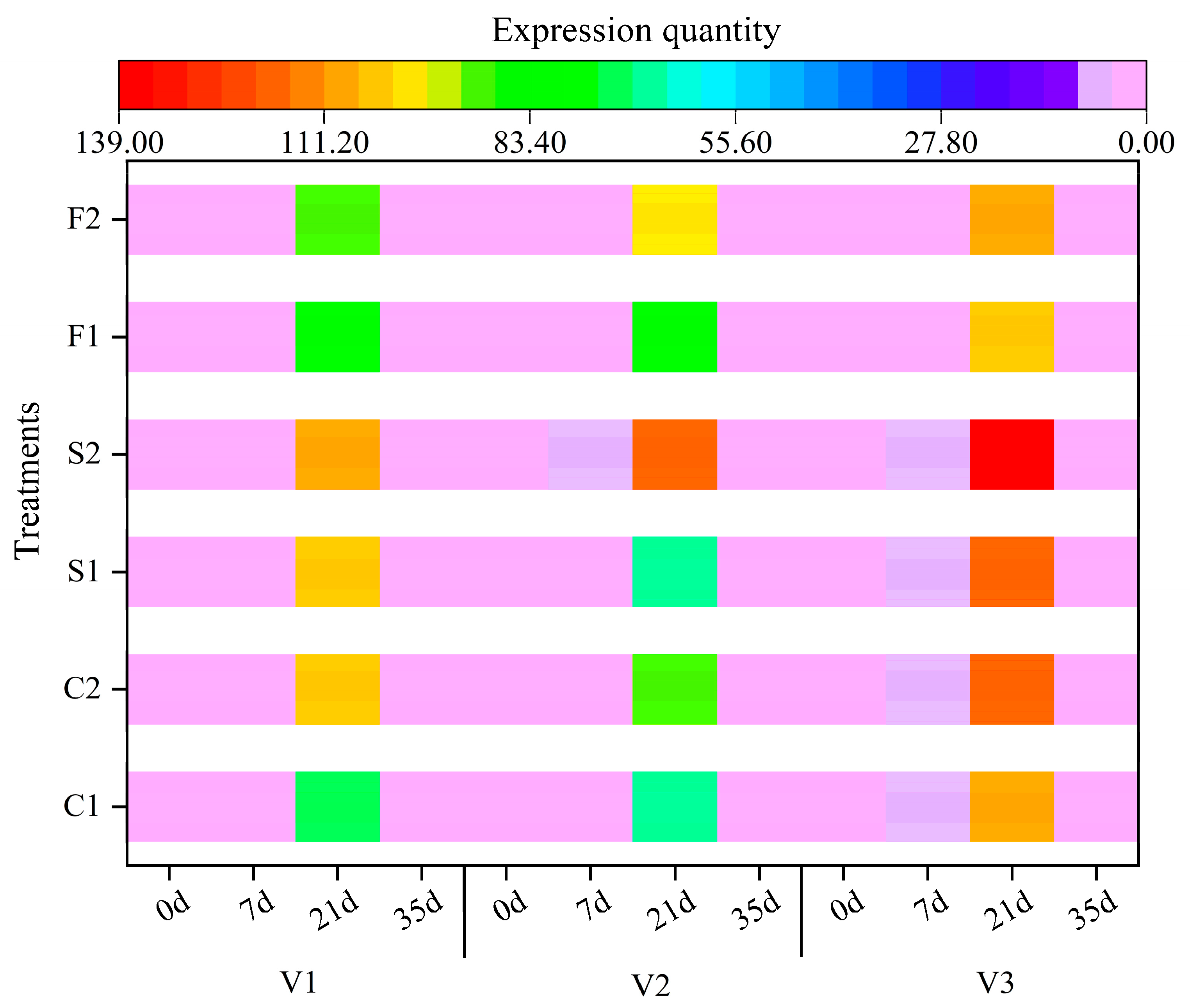
| Year | Organic Matter (g kg−1) | Total N (g N kg−1) | Available N (mg N kg−1) | Total P (g P kg−1) | Available P (mg P kg−1) | Total K (g K kg−1) | Available K (mg K kg−1) | pH |
|---|---|---|---|---|---|---|---|---|
| 2021 | 10.37 | 0.81 | 48.91 | 0.69 | 27.43 | 29.33 | 108.30 | 8.14 |
| 2022 | 9.21 | 0.75 | 46.87 | 0.68 | 27.11 | 26.87 | 176.00 | 8.31 |
| Fertilizer Types | Fertilization Treatments | Amounts of Organic Manure Application | N | P2O5 | K2O |
|---|---|---|---|---|---|
| (t ha−1) | (kg ha−1) | (kg ha−1) | (kg ha−1) | ||
| Chicken manure | C1 | 5.8 | 0 | 6 | 18.2 |
| C2 | 11.6 | 0 | 12 | 36.4 | |
| Chemical fertilizer | F1 | 0 | 112.5 | 75 | 67.5 |
| F2 | 0 | 225 | 150 | 135 | |
| Sheep manure | S1 | 12.5 | 0 | 12.5 | 11.2 |
| S2 | 25 | 0 | 25 | 22.4 | |
| CK | No fertilizer | 0 | 0 | 0 | 0 |
| Gene | Forward Primer | Reverse Primer | Method |
|---|---|---|---|
| apt1 | GTTTATGAATGCGCTTGTCTCA | TAGAGCTGACCAGGACAAACA | qRT-PCR |
| fad2a | CGTGGATCGAGACTACGGGTTA | ATGGTGCGCGACATGTGT | |
| fad3a | GACTTCAAAACTGTGGCTCT | GATAGCCACACCATTGGTGC | |
| fad3b | GCAGCGGTCTTGATTTCAACA | ATTTTGAGGACCGGAGCGAA |
| Treatments | 14 Days after Anthesis | 21 Days after Anthesis | 28 Days after Anthesis | 35 Days after Anthesis | 42 Days after Anthesis | |||||||||||||||||||||
|---|---|---|---|---|---|---|---|---|---|---|---|---|---|---|---|---|---|---|---|---|---|---|---|---|---|---|
| PAL | STE | OLE | LIO | LIN | PAL | STE | OLE | LIO | LIN | PAL | STE | OLE | LIO | LIN | PAL | STE | OLE | LIO | LIN | PAL | STE | OLE | LIO | LIN | ||
| V1 | C1 | b | e | a | c | b | a | cd | ab | c | ab | bc | bcd | a | c | c | c | bc | a | cd | b | ab | b | a | a | b |
| C2 | c | e | abc | b | a | a | de | abc | c | ab | b | cd | bc | a | a | c | d | b | b | ab | bc | bc | bc | a | ab | |
| S1 | b | cd | ab | c | b | a | de | a | c | ab | c | bc | bc | abc | b | bc | cd | b | b | ab | d | b | a | b | ab | |
| S2 | c | de | bc | b | a | a | e | cd | a | a | bc | bcd | c | ab | b | c | cd | c | a | a | d | c | b | ab | a | |
| F1 | b | a | bcd | d | b | a | a | d | bc | ab | bc | a | bc | ab | c | ab | ab | b | d | b | b | a | cd | b | ab | |
| F2 | a | b | cd | d | b | a | bc | abc | c | b | b | b | d | a | b | bc | a | c | a | b | c | bc | bc | ab | ab | |
| CK | b | bc | d | a | c | a | b | bcd | ab | b | a | d | b | bc | bc | a | a | a | c | c | a | a | d | ab | ab | |
| V2 | C1 | b | b | d | b | ab | b | b | a | c | ab | ab | c | b | a | abc | b | de | b | bc | abc | ab | b | a | bc | b |
| C2 | a | cd | cd | a | a | b | cd | ab | a | a | a | cd | c | a | a | b | cd | d | a | a | bc | b | a | ab | ab | |
| S1 | b | bc | a | b | ab | ab | bc | bc | bc | a | a | d | a | a | bc | b | c | a | bc | bc | c | b | a | d | ab | |
| S2 | b | cd | abcd | ab | ab | b | d | cd | a | a | b | d | b | a | ab | b | e | bc | ab | a | c | b | b | cd | a | |
| F1 | ab | bcd | abc | b | ab | a | a | ab | bc | b | ab | b | c | b | ab | a | a | cd | d | c | bc | a | b | ab | ab | |
| F2 | a | d | bcd | ab | ab | ab | b | d | ab | a | ab | b | c | b | ab | b | b | d | ab | ab | bc | b | bc | a | ab | |
| CK | b | a | ab | b | b | ab | a | bcd | c | ab | ab | a | b | b | c | a | b | cd | cd | bc | a | a | c | c | ab | |
| V3 | C1 | ab | a | b | d | bcd | cd | de | ab | b | ab | a | b | a | d | ab | a | c | a | bc | b | bc | c | a | bc | abc |
| C2 | b | a | b | b | bc | cd | e | ab | a | ab | b | cd | a | d | ab | a | c | a | abc | b | c | d | ab | a | ab | |
| S1 | c | ab | b | cd | ab | a | cd | a | b | ab | ab | bc | a | b | b | a | c | a | bc | ab | a | cd | ab | ab | bc | |
| S2 | c | b | b | a | ab | d | e | ab | b | a | ab | d | bc | a | ab | a | c | a | ab | ab | bc | d | b | bc | a | |
| F1 | ab | a | b | cd | cd | abc | b | bc | b | ab | ab | a | b | c | b | a | ab | b | c | ab | bc | a | b | d | bc | |
| F2 | a | b | b | bc | d | ab | c | c | b | ab | ab | bcd | bc | b | ab | a | b | b | a | a | ab | b | b | abc | abc | |
| CK | d | ab | a | e | a | bcd | a | bc | b | b | ab | a | c | cd | a | a | a | b | abc | a | ab | a | b | cd | c | |
| Variety | ** | ** | ** | ** | ** | NS | NS | ** | ** | ** | ** | ** | ** | ** | ** | ** | NS | ** | ** | ** | ** | NS | ** | ** | ** | |
| Fertilization | ** | ** | ** | NS | * | ** | ** | ** | ** | ** | ** | ** | ** | * | ** | * | ** | ** | * | ** | ** | ** | * | * | NS | |
| Treatments | 14 Days after Anthesis | 21 Days after Anthesis | 28 Days after Anthesis | 35 Days after Anthesis | 42 Days after Anthesis | |||||||||||||||||||||
|---|---|---|---|---|---|---|---|---|---|---|---|---|---|---|---|---|---|---|---|---|---|---|---|---|---|---|
| PAL | STE | OLE | LIO | LIN | PAL | STE | OLE | LIO | LIN | PAL | STE | OLE | LIO | LIN | PAL | STE | OLE | LIO | LIN | PAL | STE | OLE | LIO | LIN | ||
| V1 | C1 | bc | bcd | ab | a | a | ab | bc | a | ab | bc | b | c | a | a | b | ab | cd | ab | ab | abc | bc | b | a | a | ab |
| C2 | c | d | ab | a | a | b | d | a | a | ab | b | bc | abc | ab | ab | c | d | ab | a | a | bc | ab | b | ab | a | |
| S1 | bc | d | a | a | a | ab | cd | a | ab | abc | b | abc | ab | bc | ab | ab | c | a | ab | bc | ab | b | a | ab | bc | |
| S2 | c | cd | ab | a | a | b | b | ab | bc | a | b | c | abc | bc | a | bc | cd | ab | ab | ab | c | ab | b | ab | a | |
| F1 | a | ab | ab | a | b | a | ab | b | c | c | a | ab | bc | c | b | a | b | ab | b | abc | abc | ab | b | ab | bc | |
| F2 | bc | abc | b | a | a | ab | a | b | c | abc | a | abc | bc | ab | b | ab | b | ab | b | abc | abc | ab | b | a | abc | |
| CK | b | a | b | a | a | ab | ab | ab | bc | c | a | a | c | abc | b | a | a | b | b | c | a | a | b | b | c | |
| V2 | C1 | ab | a | a | a | abc | bc | b | a | ab | ab | b | b | a | a | ab | ab | cd | ab | bc | abc | bc | bc | a | b | ab |
| C2 | b | a | abc | a | ab | bc | b | a | a | a | b | b | ab | a | a | b | cd | bc | ab | ab | d | b | a | a | ab | |
| S1 | ab | a | abc | a | bc | bc | b | a | a | ab | a | b | a | a | ab | ab | cd | a | c | abc | ab | bc | a | ab | ab | |
| S2 | b | a | ab | a | a | c | b | a | a | a | b | b | ab | a | a | c | d | abc | ab | a | d | c | a | ab | a | |
| F1 | a | a | bc | a | c | a | a | ab | c | b | a | a | ab | a | b | a | b | bc | bc | bc | a | bc | a | ab | ab | |
| F2 | ab | a | c | a | abc | ab | a | ab | bc | ab | a | a | b | a | ab | b | bc | c | a | abc | c | bc | a | ab | ab | |
| CK | ab | a | abc | a | abc | abc | a | b | c | a | a | a | ab | a | b | b | a | bc | c | c | ab | a | a | c | b | |
| V3 | C1 | a | b | a | ab | a | c | abc | a | abc | c | ab | c | a | ab | ab | a | c | a | a | bcd | ab | b | ab | ab | ab |
| C2 | b | ab | abc | a | a | c | bc | ab | a | ab | b | c | ab | ab | a | a | c | ab | a | ab | b | b | ab | ab | ab | |
| S1 | ab | ab | ab | bc | a | bc | abc | a | ab | c | ab | c | a | ab | ab | a | c | a | a | abc | ab | b | a | b | ab | |
| S2 | b | ab | ab | a | a | c | c | ab | ab | a | b | c | a | a | a | a | c | ab | a | a | b | b | ab | ab | a | |
| F1 | a | a | bc | c | a | a | ab | ab | d | c | a | b | bc | b | ab | a | ab | ab | a | cd | a | b | ab | ab | ab | |
| F2 | a | a | abc | bc | a | ab | ab | b | bcd | bc | a | b | c | ab | ab | a | b | ab | a | abc | ab | b | b | a | ab | |
| CK | a | a | c | bc | a | ab | a | ab | cd | c | a | a | c | b | b | a | a | b | a | d | ab | a | b | ab | b | |
| Variety | ** | ** | ** | ** | ** | ** | ** | ** | ** | ** | NS | ** | ** | ** | NS | ** | ** | ** | ** | ** | ** | ** | ** | ** | ** | |
| Fertilization | ** | ** | * | ** | ** | ** | ** | ** | NS | NS | NS | ** | ** | ** | NS | ** | ** | ** | NS | NS | * | ** | ** | ** | NS | |
Disclaimer/Publisher’s Note: The statements, opinions and data contained in all publications are solely those of the individual author(s) and contributor(s) and not of MDPI and/or the editor(s). MDPI and/or the editor(s) disclaim responsibility for any injury to people or property resulting from any ideas, methods, instructions or products referred to in the content. |
© 2024 by the authors. Licensee MDPI, Basel, Switzerland. This article is an open access article distributed under the terms and conditions of the Creative Commons Attribution (CC BY) license (https://creativecommons.org/licenses/by/4.0/).
Share and Cite
Ma, X.; Gao, Y.; Ma, X.; Wu, B.; Yan, B.; Li, Y.; Wang, Y.; Xu, P.; Wen, M.; Wang, H.; et al. Effect of Different Types of Organic Manure on Oil and Fatty Acid Accumulation and Desaturase Gene Expression of Oilseed Flax in the Dry Areas of the Loess Plateau of China. Agronomy 2024, 14, 381. https://doi.org/10.3390/agronomy14020381
Ma X, Gao Y, Ma X, Wu B, Yan B, Li Y, Wang Y, Xu P, Wen M, Wang H, et al. Effect of Different Types of Organic Manure on Oil and Fatty Acid Accumulation and Desaturase Gene Expression of Oilseed Flax in the Dry Areas of the Loess Plateau of China. Agronomy. 2024; 14(2):381. https://doi.org/10.3390/agronomy14020381
Chicago/Turabian StyleMa, Xingkang, Yuhong Gao, Xingbang Ma, Bing Wu, Bin Yan, Yue Li, Yifan Wang, Peng Xu, Ming Wen, Haidi Wang, and et al. 2024. "Effect of Different Types of Organic Manure on Oil and Fatty Acid Accumulation and Desaturase Gene Expression of Oilseed Flax in the Dry Areas of the Loess Plateau of China" Agronomy 14, no. 2: 381. https://doi.org/10.3390/agronomy14020381
APA StyleMa, X., Gao, Y., Ma, X., Wu, B., Yan, B., Li, Y., Wang, Y., Xu, P., Wen, M., Wang, H., Wang, Y., & Guo, L. (2024). Effect of Different Types of Organic Manure on Oil and Fatty Acid Accumulation and Desaturase Gene Expression of Oilseed Flax in the Dry Areas of the Loess Plateau of China. Agronomy, 14(2), 381. https://doi.org/10.3390/agronomy14020381





